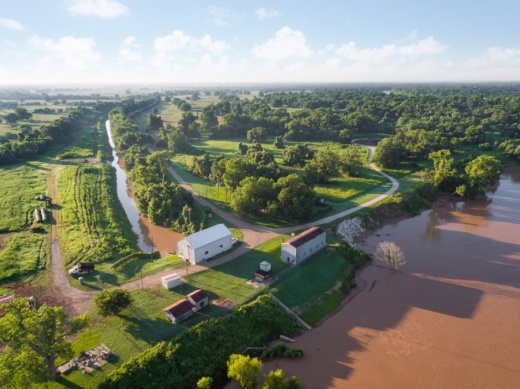Pearland’s surface water treatment plant will deliver 10 million gallons of clean drinking water to Pearland every day once completed in 2023.
In 2016, the city of Pearland took steps to increase its water supply by adding a surface water treatment plant, a project that will cost the city $178.4 million, to the city’s capital improvement projects. The city broke ground on the treatment plant last May.
The surface water treatment plant will treat water coming in from the Gulf Coast Water Authority, which serves Fort Bend, Brazoria and Galveston counties by bringing in water from the Brazos River. As the city grows, Pearland will continue to explore diversifying its water sources, which already include local wells, the Gulf Coast Water Authority and the city of Houston.
“We want to maintain water rates and be the best purveyor of the water we have,” Pearland Director of Engineering Robert Upton said.
Bringing the plant online
The surface water treatment plant project was divided into three phases for design, and construction is expected to be completed in late 2022 or early 2023. The plant will be located west of CR 48 at Mustang Bayou.
The need for the surface water treatment plant plays into the city’s desire to provide water for all of its future residents, Upton said. The city has grown by 25% in the last five years and is expected to continue to grow.
“When the surface water treatment plan comes online in 2023, we will have three sources of water,” Upton said. “Then if Houston has to do maintenance, we can still maintain our supply.”
The city of Houston is one of those three sources. The city provides water to 16 other cities in the Houston region, including Friendswood and League City, Houston Public Information Officer Erin Jones said in an email.
Another provider of water for Pearland is the Gulf Coast Water Authority. Once completed, the surface water treatment plant will treat water the city receives from the Brazos River through the Gulf Coast Water Authority’s canal, making it safe for drinking, Gulf Coast Water Authority CEO Brandon Wade said. The ability to pull water from the canal was one of the deciding factors on where to put the surface water treatment plant, Wade said.
The Gulf Coast Water Authority has a contract with the city of Pearland, which allows the city to produce and use 10 million gallons of water a day, Upton said. The city does not have to use that many gallons daily, although it does have to pay for it, Wade said.
A significant portion of funding for the surface water treatment plant will come from the impact fees, which are paid by developers. The other portion of funding is paid for through water and sewer revenue bonds, a portion of which is funded through Pearland’s residential utility bills, interim Director of Finance John McCarter said.
Water costs in the city have risen for a number of reasons, one of which being the need for more water infrastructure, including the surface water treatment plant, several council members mentioned at the city’s Jan. 25 council meeting.
“We are moving toward more water independence,” Council Member Adrian Hernandez said at the meeting. “In that future vision of the surface water treatment plant, we will be in very good shape compared to some of our neighbors.”
Diversifying water sources
As the Houston region grows, more cities are seeing a need to diversify their water sources, Wade said.
The Gulf Coast Water Authority provides about 200 million gallons of water a day to its cities and counties, where it is cleaned for consumption, as well as agricultural and industrial businesses. Cities and counties can build their own plants to clean the water, like Pearland is, or the Gulf Coast Water Authority can build the plants for them, Wade said.
“We will contract for a certain amount of water over the agreed amount of time,” Wade said. “They may not need the water, but it’s available to them.”
Most city leaders want to look at their water portfolios and diversify, Upton said. Not only does the city have surface water, it has ground water, too; both are limited resources. Ground water is pulled up by a well; the city of Pearland has 11 wells dispersed throughout the city. However, the Gulf Coast Water Authority still has water it can contract out to those that need it, which can include those in agricultural and industrial fields, Wade said.
In the future, the Gulf Coast Water Authority could start supplying water to smaller cities or special districts, such as municipal utility districts.
In the past, cities such as Pearland took care of special districts’ water needs through involuntary annexations. Because legislative changes in 2017 no longer allow cities to conduct involuntary annexations, special districts have to find their own sources of water, Wade said.
Smaller cities such as Manvel and Iowa Colony will also need more water as they grow, Wade said.
“They have other options. They are expecting significant growth,” he said.
The city of Pearland could contract with these smaller cities to provide water in the future; however, it is a discussion several years and several steps away, Upton said.
Future of water
As the Houston region continues to grow, cities and companies are paying more attention to how to provide water sustainably.
Providing water to so many cities reduces the amount of groundwater the region uses, Jones said in an email.
“The city of Houston is committed to being a regional supplier of safe, reliable drinking water,” Jones said. “We continue to seek new sources of water to meet future needs, develop existing water resources, and plan for and invest in water conveyance and treatment infrastructure to benefit Houston and the greater Houston region.”
The Gulf Coast Water Authority has authority to pull no more than 400,000 acre feet of water per year, and it must allow some of the water to pass to protect the coastal estuaries. However, that is not the only thing it is looking at to help the environment while still providing water. The Gulf Coast Water Authority is also looking at water reuse, or treating and reusing wastewater. Another option is desalination of seawater and brackish water, or water pulled from deep underground, Wade said.
“You can pull seawater out of the Gulf and pull the salt out of it and treat it to where it is drinkable,” Wade said. “It is six to 10 times the cost of pulling water out of the Brazos, so it is expensive. But, because Texas is growing as a whole, there will be competition for water supplies.”
Pearland leaders also want to be good stewards of the water resources the city has, Upton said.
“Council and the city want to be good stewards of the resource,” Upton said. “You can see that we take all [environmental] impacts as important.”•





